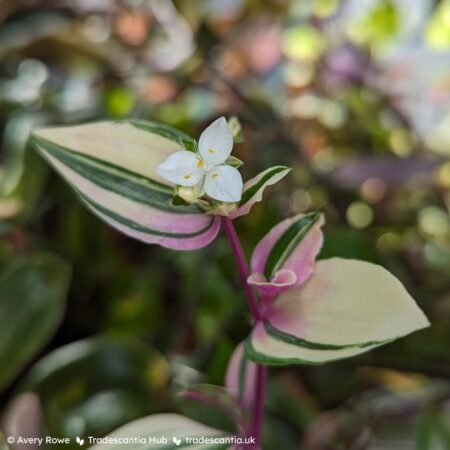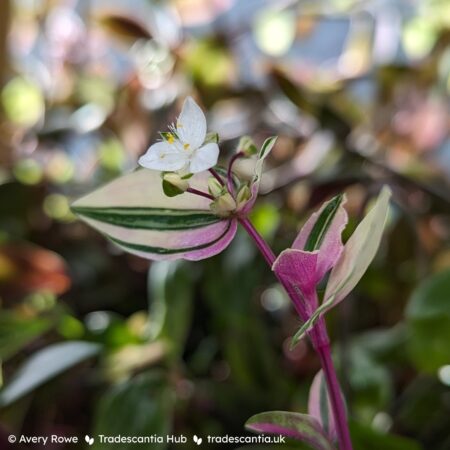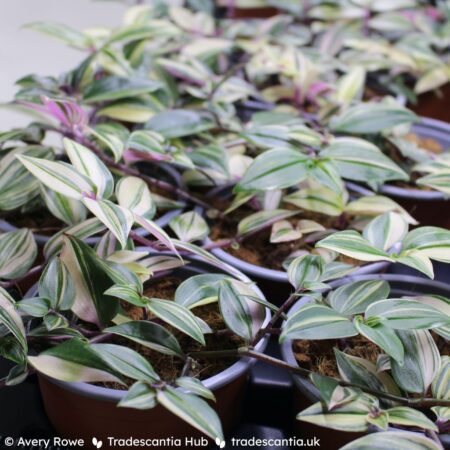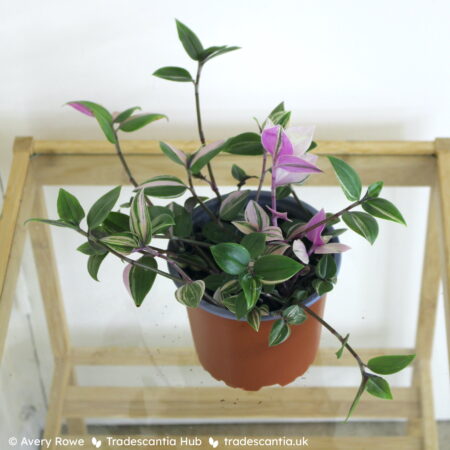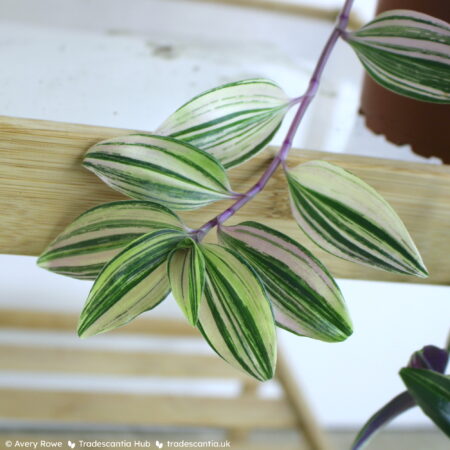Details
| Full name | Tradescantia mundula ‘Lisa’. |
| Name status | Accepted, the valid name for a unique cultivar. Established with a description by Bastiaansen (1992). This is a plant breeder’s rights registration, so the name must be adopted over any earlier name and kept even after the registration expires (Brickell et al., 2016, Arts. 11.3, 11.4). Also known as:
|
| Origins | In the plant breeder’s rights registration (Bastiaansen, 1992), the plant is described as new. However, these is evidence of the plant existing many years earlier under the name ‘Tricolor’ (Simms, 1967, p. 9), so its true origins are unknown. |
| Classification | In the plant breeder’s rights registration (Bastiaansen, 1992), the plant is described as a cross between Callisia repens ‘Bianca’ and an unnamed Tradescantia. However, intergeneric crosses are very rare and there is no evidence for this. The plant is now identified as Tradescantia mundula based on Pellegrini (2018). |
| Legal protection | None. Previously protected by plant breeder’s rights in the Netherlands, but surrendered in 1997 (Bastiaansen, 1992). |
| Availability | Mass-produced and widely available around the world. |
Description
Preserved in a herbarium specimen (“Tradescantia mundula ‘Lisa'”, 2023).
Described with reference to the RHS Colour Chart (6th Edition: 2019 reprint).
| Species | Tradescantia mundula. |
| Growth habit | Delicate, creeping stems which will spread out of any container and trail downwards. |
| Foliage | Stems are 2-3mm wide with internodes 1-5cm long, smooth except for one line of tiny hairs running the length. The colour ranges from greyish reddish purple (N77B) on new growth to greyish olive green (NN137A) on old stems. Leaves are slightly asymmetrical pointed ovals, 2-5cm long and 1-2.5cm wide, scattered with bristly hairs, particularly on the undersides. The base colour of the leaves is moderate olive green (137A) on the upper surface. They are randomly striped with light areas, covering 0-100% of the surface. The light areas range from pale yellow (158A) to light purple (77D). Leaf undersides are moderate yellow green (147B), with light areas showing through pale yellow green (157A), and sometimes becoming flushed with strong reddish purple (N78B) to dark purple (83A). Leaf sheaths are pale purple (N75C) to very light purple (76B). More intense light brings out the purple colours, whereas in lower light the leaves are overall more green and yellow. |
| Flowers | Flowers are 10mm across. Petals are pure white with slightly pointed tips. Anthers are yellow, stamen filaments and pistil are white. |
References
Simms, W. F. (1967). A Re-appraisal of the “Tradescantias”. Gardener’s Chronicle, 162(25), 8-9.
Bastiaansen. (1992, October 1). Tradescantia ‘Lisa’ [Netherlands plant breeder’s rights registration 12254]. Community Plant Variety Office. Registration document link.
Brickell, C. D., Alexander, C., Cubey, J. J., David, J. C., Hoffman, M. H. A., Leslie, A. C., Malécot, V., Jin, X. (2016). International Code of Nomenclature for Cultivated Plants. PDF link.
Pellegrini, M. O. O. (2018). Wandering throughout South America: Taxonomic revision of Tradescantia subg. Austrotradescantia (D.R.Hunt) M.Pell. (Commelinaceae). PhytoKeys 104: 1-97. Open access link.
Tradescantia mundula ‘Lisa’. (2023). [Herbarium specimen, barcode WSY0168558]. RHS Wisley Herbarium.

